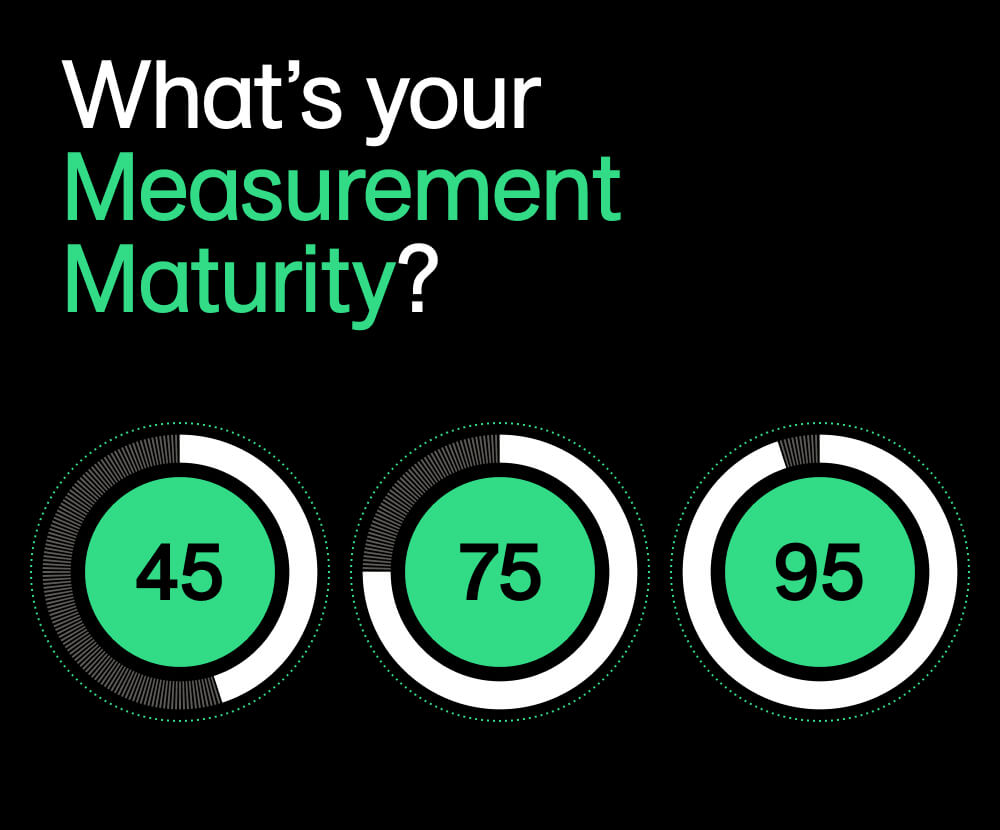Every organization’s marketing capabilities evolve over time. As you grow, your marketing efforts scale – you add new channels to the mix and work with new partners.
Yet too often, companies don’t scale their marketing measurement tactics effectively alongside growth. This can result in inefficient resource allocation, missed opportunities for optimization, and a lack of clear insight into what’s driving performance.
In an environment of tighter budgets and an increasing need to demonstrate marketing impact, improving your measurement maturity ensures data accuracy so you can make informed business decisions and continually improve ROI. Assessing your current marketing measurement maturity level is the first step to building a measurement framework that aligns with your organization’s growth and goals.
What is marketing maturity?
Organizations with a high level of marketing maturity have a fully integrated marketing strategy that encompasses product positioning, brand strategy, customer experience, and more. They’re able to execute campaigns that align with high-order business objectives and accurately measure success. By ensuring that every decision is backed by data, they can quickly adapt to changing customer needs and market conditions.
What is marketing measurement maturity?
Marketing measurement maturity is the degree to which an organization can measure and optimize its media and advertising efforts. It’s about having the right methodologies, data tools, and expertise to evaluate campaign effectiveness across all online and offline channels.
Most importantly, the ability to consolidate data from siloed channels into a unified measurement view is what differentiates basic campaign analytics from comprehensive, value-driven marketing.
Organizations with mature marketing measurement capabilities are able to connect metrics like ad impressions or clicks to tangible business outcomes such as brand loyalty, incremental sales lift, and customer lifetime value. They leverage measurement insights to make data-backed adjustments to their marketing strategies, ensuring continual alignment between campaign results and business goals.
The benefits of marketing measurement maturity
As your organization moves up the measurement maturity scale, you unlock new benefits and opportunities to optimize your marketing and media investments. With a robust marketing measurement strategy in place, you can do a better job of fine-tuning campaigns, maximizing ROI, and staying ahead of competitors in a data-driven landscape.
Optimize campaigns with data-driven insights
Comprehensive measurement provides a deeper understanding of marketing performance. Uncovering this data enables you to recognize whether you’re reaching the right audience on the right channels with the right message. Additionally, comprehensive measurement allows for predictive insights so you can make strategic decisions about future marketing initiatives. McDonald’s measurement strategy unlocks an enterprise-wide view of customers that enables actionable media insights and stronger ROI.
Improve cross-channel measurement
By understanding how different channels interact, you can reduce redundancy and boost efficiency. A unified view of your cross-channel campaign data helps you pinpoint which channels are driving the highest value and make more informed decisions about where to allocate resources.
Biopharmaceutical company AbbVie enables cross-channel measurement with sophisticated tactics that allow the marketing team to understand how complex media campaigns impact customer behavior. With a better understanding of customer journeys, AbbVie can tailor its marketing activations in real time to drive business results.
Scale campaigns more effectively
A strong measurement foundation allows marketing efforts to scale. For example, Hershey’s uses the LiveRamp clean room to activate its first-party data and accurately track customer journeys across walled-garden platforms and retail media networks. Now the Hershey’s team can strategically scale media campaigns for their 90 brands while ensuring they’re not reaching the same customers too often.
Drive broader business goals
A mature marketing measurement strategy helps ensure media campaigns are aligned with higher-order business objectives. This enables you to justify media investments with hard data and allows stakeholders to see the direct link between marketing activities and organizational success.
Download our Measurement Primer for Brands to unlock the essential components of a measurement strategy and best practices for upleveling your approach and maximizing return on ad spend.
What is a measurement maturity model?
A measurement maturity model is a framework that helps marketers evaluate their current capabilities for measuring the impact of media and advertising investments. It provides a roadmap that shows you where you are now and what steps you need to take to improve.
By assessing maturity across different dimensions — such as data integration, analytics tools, identity resolution, and optimization processes — you can systematically advance to more sophisticated marketing measurement practices. This approach provides transparency into which tactics are working and helps guide strategic decisions that maximize return on ad spend.
The 4 stages of measurement maturity for media and advertising
Achieving measurement maturity is a gradual process, which is why we break it down into stages. These stages provide a roadmap for growth, moving from basic metrics tracking to fully integrating data from multiple sources to uncover strategic insights. By knowing which stage your organization is in, you can take targeted actions to advance your measurement capabilities and drive greater impact.
1. Emerging
At the emerging stage, you are just beginning to establish measurement processes. Your data is often siloed, with minimal integration between channels, and you may only be tracking basic metrics like impressions and clicks.
2. Building
You enter the building stage when you begin integrating data across channels. This allows you to apply more advanced analytics like conversion tracking and customer journey mapping. However, the insights you generate are still somewhat fragmented.
3. Developing
By the time you reach the developing stage of measurement maturity, you’ve established a solid data foundation for effective measurement. This might include an identity resolution framework enabled by a data clean room, allowing for deeper insights and strategic optimization.
4. Leading
Organizations leading in their marketing measurement maturity can confidently attribute business outcomes across all channels, predict campaign performance, and align media strategies with overall business goals.
At this stage, you’ve mastered closed-loop measurement. Closed-loop models enable you to link exposure data from advertising campaigns to first-party sales data in a privacy-centric way, allowing you to understand which advertising tactics meaningfully contribute to the bottom line and identify areas that need improvement.
How to measure your media and advertising maturity
Understanding your current level of measurement maturity involves evaluating your current processes against the maturity model stages.
- Assess your data integration: Do you have a unified view of customer data across all channels? Are there any data silos preventing seamless integration across teams or platforms?
- Evaluate your tool sophistication: Are your analytics tools capable of providing actionable insights beyond basic KPIs? Do your tools enable predictive analytics to anticipate trends and inform proactive decisions?
- Check alignment between your measurement model and business goals: Does your measurement strategy support broader business objectives? Are your key metrics and reporting frameworks tailored to reflect your organization’s strategic priorities?
Not sure how to get started? LiveRamp’s measurement maturity assessment can help you benchmark your current position and identify opportunities for growth. Just answer six simple questions about your current approach, and we’ll provide you with actionable advice to advance to the next stage of measurement maturity.
Improve media and ad spend measurement with LiveRamp
LiveRamp’s cross-media measurement and analytics capabilities support organizations at every stage of their measurement maturity journeys.
Whether you’re just beginning to integrate data or already optimizing campaigns for business outcomes, LiveRamp can provide the infrastructure and tools you need to take control of your data, improve media efficiency, and uncover new insights.
Now is the time to move beyond basic metrics – reach out to get started.

